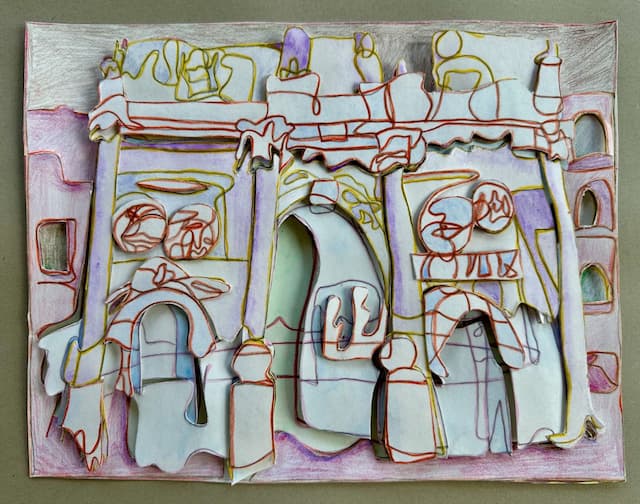Behind the Artist Persona
 Much is said these days about being “authentic.” We want authentic worship, authentic leadership, authentic community. But the reality is that authenticity can be a scary, daunting, and difficult virtue to live out. We are all walking wounded—carrying the baggage of our dysfunctional backgrounds, the consequences of our sins, the lies we’ve chosen to believe about ourselves. None of us are whole in and of ourselves.
Much is said these days about being “authentic.” We want authentic worship, authentic leadership, authentic community. But the reality is that authenticity can be a scary, daunting, and difficult virtue to live out. We are all walking wounded—carrying the baggage of our dysfunctional backgrounds, the consequences of our sins, the lies we’ve chosen to believe about ourselves. None of us are whole in and of ourselves.
I think it may be harder still for those of us who have a public persona—such as a musical artist, actor, speaker, worship leader, or church pastor—those of us who have an identity on the stage.
Ever thought about the nature of what a worship leader does? We stand in front of a group of people, painfully aware of how audaciously center stage we are during worship—and our job is to give God the glory. The lights are on us, the focus is on us, the music is driven by us. We sing songs in our key to highlight our voices and showcase our playing. We strut and we pose and we stir up the people, trying to generate a positive response from the crowd. And afterwards, those very same people come up to us and tell us how great we are. It’s got to be one of the weirdest things in the world.
Go to a pastor’s conference and you’ll see this happen. There is some unspoken but inevitable posturing, as those with large churches secretly measure themselves against those who do not, while those loyal leaders of the very small congregations try to maintain some semblance of self-respect in light of their apparent shortcomings. Everyone generally tries very hard to ignore the measuring stick of attendance figures at these gatherings, but it’s difficult because the worship is accompanied by dazzling multimedia, smoke machines, and laser lights, and the keynote speaker is usually a visionary mega-church pastor. Certainly everyone is trying to be “authentic,” but the reality is that everyone’s public persona is on full display. You might think this unholy, and maybe it is. But it is also very human, and inside us all.
The deadly sin here is pride. Pride is thinking and acting about yourself before others. It is more than just being conceited or big-headed. Even people with low self-esteem have issues with pride, because it is rooted in a self-centeredness that comes from the same place—We don’t have a proper understanding of our true identity in Christ and our true worth from Christ. And this is a shame, because it is only in truly understanding our place before God that we fully see Him for the good and great God that He is.
We as artists seem to be greatly motivated by our neediness for acceptance and approval. And even though we are Christ followers, the unspoken truth is that we are also driven by our egos in dark and complex ways.
At the root of all of this is the issue of identity. And while I caveat the remainder of this article on identity by stating that I’m not a psychologist (I’m really just a knuckle-head musician), I have found this understanding helpful to myself and to others I’ve counseled. What I tell you comes from personal experience, not from an academic understanding.
THE NATURE OF IDENTITY
One can argue that there are four aspects to your identity, four personas, if you will: Who you think you are, Who you try to portray yourself to be, Who people actually experience when they encounter you, and Who God sees.
Persona 1: Who You Think You Are
We all have a sense of self that defines us, and our actions spring from this sense of self. But all of us think things about ourselves that aren’t true, or at least are skewed from the truth. We have defense mechanisms, identity issues, wrong self-image, family-of-origin issues, all sorts of stuff. And these things lead to the dysfunctions that keep us from becoming like Christ.
For example, someone may grow up having heard over and over that they are stupid. And so, while they might never verbalize it, they constantly hear a voice in their head that tells them so. When they do something wrong, it confirms this wrong self-identity, and this confirmation becomes the trigger to continue the cycle of subconscious self-deprecation. It takes a great deal of self-awareness to break the cycle.
As another example, we might believe, at some deeply fundamental level, that our identity comes from our accomplishments. So we spend our lives trying to earn awards, trophies, and other achievements to earn the approval of others. But somehow, it never seems to be enough. I’ve found this to be very true of many musicians and other artists, who seek approval and acceptance through their art. And this seems to work okay as long as people like what you do. However, the problem is that if you believe that your identity comes from your artistic expressions (instead of the other way around), then if someone doesn’t like your song or painting or poem, then you believe that they must not like you. And this thinking is not only skewed, but damaging to the soul.
Persona 2: Who You Try to Portray Yourself to Be
Who you think you are leads to image management, which is trying to control the way that people see you. If we like who we think we are, we will do things to try to represent that to others. If we don’t like who we think we are, we will do things to hide that from others. The reality for most of us is that we end up doing both. Examples of this include trying to wear a wardrobe to give off a particular image, name dropping (By the way, Bono told me once never to drop names), writing your webpage in the third person, or one of the artists’ favorite image management tools, false humility. One of the Facebook trends I see a lot is when artists use spiritual posts that are really just thinly veiled bragging, e.g., “Please pray for me as I’m about to take the stage at mega-huge convention’s main stage!”
There is an irony here. As performers who act, sing, or play on-stage, we have a public persona that is different than our personal persona. We talk about stage presence which is a necessary part of being a performer. But if you are a performing artist of any renown, your stage presence follows you off the stage. So by trade, we are trained to manage our images. It is, to some degree, a necessary thing. But often what happens is that our “fans” end up having a relationship with who they think we are, not who we really are. (By the way, here’s a good image management exercise to try: Write a completely honest press release about yourself. It’s harder than it seems.)
There are a lot of reasons why we image manage. Maybe we learned how to protect ourselves from criticism by pretending to be something else. Maybe we feel the need to prove ourselves, so we’ve learned how to subtly drop off our verbal resumes in conversation. Maybe we feel that advertising our accomplishments is a necessary part of moving up the ladder of success. And as I said, a certain amount of image management is necessary for public figures to maintain a sense of privacy in our personal lives.
Image management is no stranger to the church. Many of us have experienced church subcultures where, in an effort toward authenticity, holiness was replaced by religiosity. Our churches want us to be authentic, but not that authentic. They don’t want pastors who drink beer, elders who smoke cigars, or worship leaders who listen to Lady Gaga. They would rather we act, perform, and be good “Christians” instead be seen as the imperfectly saved sinners we really are. There is more pretending going on in the church than any of us care to admit.
So all of us—in conscious and subconscious ways—manage our images to others. But that’s not necessarily how people see us.
Persona 3: Who People Actually See When They Experience You
Have you ever known someone for whom it is obvious that they’re trying to image manage, but it’s not working? And they don’t have a clue that they are coming off that way? There’s a distinct disconnect between who they want to appear to be and who they actually come off as. (For example, the Steve Carell character in the TV series, “The Office”.) Well, yeah, actually that happens to everyone to some degree.
The actual result of image management is that no one really sees the image we want them to see. Instead, they see some skewed version of that image, which is some combination of what they experience and who we are when no one else is looking. Granted, some of us are better at pretending than others, and some of us are better at discerning people than others, but the result is still the same. Like a middle-aged man combing over his bald spot, we all walk around with some small degree of discernable inauthenticity.
All of this begs the question: Are any of these three identities valid or right? Well, to answer that question, we need to examine the fourth persona.
Persona 4: Who God Sees
Beyond all of those other personae is the person that God sees in us. He knows us through and through. He has seen every bit of us—good, bad, and ugly. He’s seen every embarrassing moment, every mistake and failure, every soul wound, every concealed sin. And here’s the most amazing part: He loves us anyway.
God not only sees the bad stuff. He sees the Imago Dei, the image of God designed into us. And as such, we have infinite and eternal worth in His eyes. So here is the crux of what I’m trying to say: This persona, Who God Sees, is the only one that really matters.
Because this is the only persona that is True.
So what does God see in you? What is your real identity in Christ? You are a child of God, whom He dearly loves (John 1:12). You are a member of a chosen race, a people for God’s own possession (1 Peter 2:9-10). You are an heir of God (Galatians 4:6). You are a joint heir with Christ, sharing in His inheritance (Romans 8:17). You are righteous and holy, set apart for God’s purposes and for His glory (Ephesians 4:24). You are an expression of the very life of Christ (Colossians 3:4). You are His workmanship, perfected through the blood of Christ, and brought to perfection through the Holy Spirit. You are God’s dearly beloved.
This is the person God sees in you. This is the persona that is eternally real. This is our True Identity. So why hold on to the false identities, when true humility in God gives us an identity that is so much better, richer, deeper, truer?
BRINGING IT ALL TOGETHER
The reality is that authenticity is not that easy. I’ve met many people who—because of their baggage and complex systems of self-deception—have a hard time breaking through to the real self. If the soul were a garden, there are parts of it that are overgrown, swampy and dark. It takes a lot of courage to walk into these darkly deformed parts of our soul and start pulling weeds.
Here is a definition of authenticity. Authenticity is the act of aligning the first three personas with the true persona, so that they are all the same. So that the person you think you are is the person you project to others, which is the person people actually see, which is the person God sees, the True Self.
In the eleventh chapter of Matthew, Jesus began preaching to the towns of Galilee. He reveals His role as the Son of God, and He offers them an invitation to a better way. Jesus says, “Come to me, all you who are weary and burdened, and I will give you rest. Take my yoke upon you and learn from me, for I am gentle and humble in heart, and you will find rest for your souls. For my yoke is easy and my burden is light.” (Matthew 11:28-30 NIV)
What I believe Jesus is saying is, in part, that you can let go of all of those false systems of religiosity and self-deception, the false devices of approval and acceptance, the false belief in earning one’s worth and salvation. All of those things that oppress and deceive and wound the soul. And instead, you can know the Father through a living and vibrant relationship with the Son (Matthew 11:27).
It’s my opinion that these issues of identity are as fundamental to the Christian walk as worship or evangelism or community. It is central to our growth as followers of Christ and artists of faith. For to be true to yourself, to your audience, and to God, you must be who God made you to be.
[Note: This is a repost of one of my blogs from August 2011. Image by Peggy Bonnett Begnaud, available at Bonnett Gallery.]








